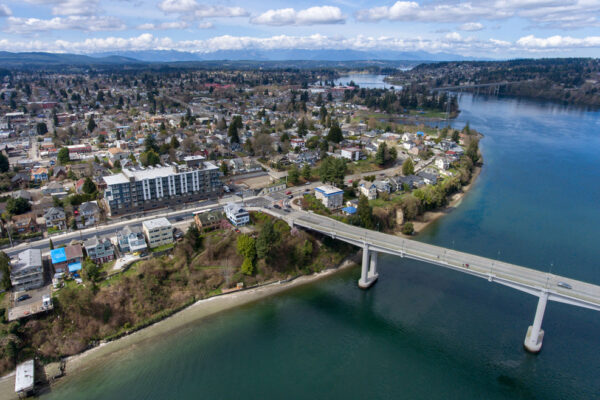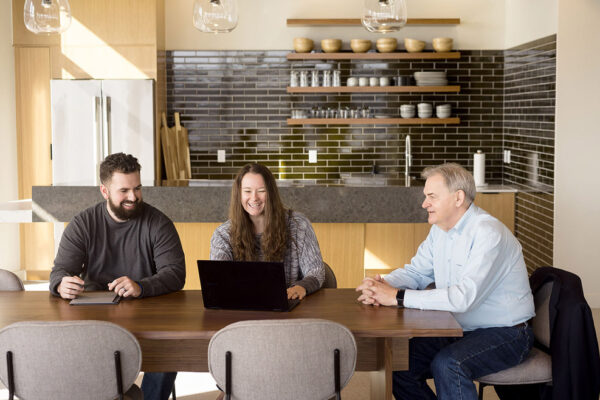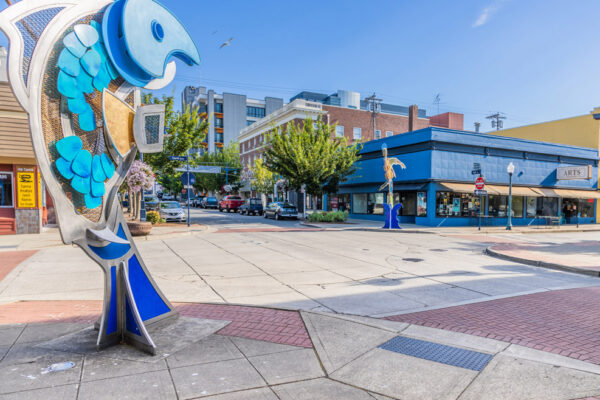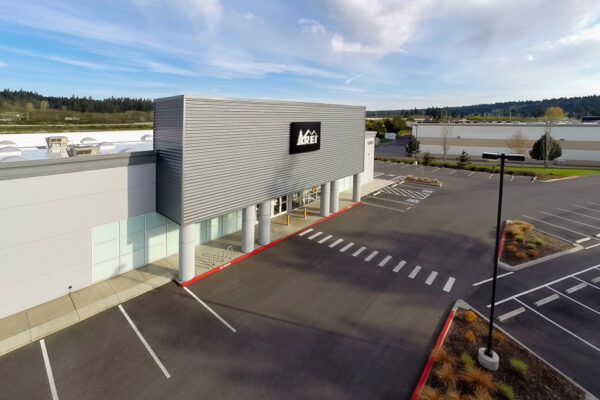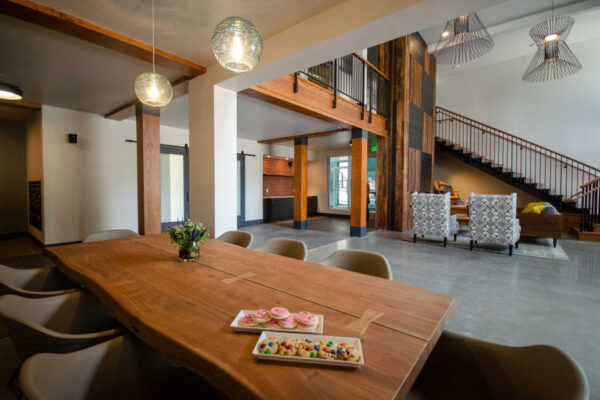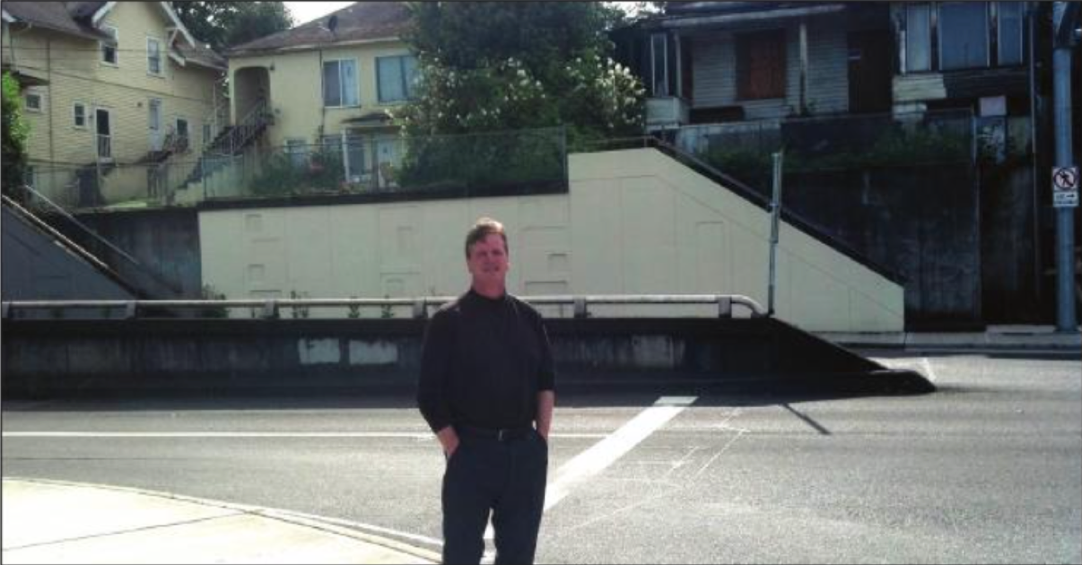Source: Kitsap Peninsula Business Journal
By: Tim Kelly
Posted: June 1, 2014

Wes Larson certainly has gone places in his career — make that careers.
The Bremerton native and UW alum who once worked at the downtown Woolworth’s as a stock boy has lived in Japan, where he taught English and studied karate. (Larson currently teaches a youth karate class at a downtown Bremerton studio.)
After going to graduate school in Arizona to get an MBA, he spent time in New York and Vienna, Austria, working in international banking; and when he and his wife, Daphne (who’s originally from Singapore and met Wes in New York), moved to Seattle in 1997 to be near his ailing father, Larson took evening classes at Seattle University and earned a law degree.
With all that education and experience on his resumé, the well-traveled Larson came full circle several years ago back to his Kitsap County roots — and a new career in real estate investment and development.
Those roots run deep, and Larson has a strong sense of place and his family’s history. In 1970, they moved from Bremerton to Silverdale (when the community had one traffic light on Silverdale Way, he notes) and lived on a 10-acre farm that today is the site of the AMC movie theater. It’s not far from the Tower Medical Center and the REI store that opened last year, two redevelopment projects managed by Larson and his partners in Sound West Group. He recalls how he used to go jogging by those properties when they were pasture land.
A century ago in Bremerton, his great-grandfather D.L. (Derward Lawton) Cady was the mayor, a philanthropist, and a local legend. Cady, who came to the Kitsap area in the 1890s and ran a general store in Brownsville, had a delivery horse named “Danger” who reportedly would make rounds towing a wagon throughout the area on his own, and return to the store when done.
Larson was born in the house next door to where his great-grandfather lived for most of his life at the corner of Sixth Street and Broadway (“Right across the street used to be Milt’s Donuts,” he recalls.) Sound West Group has plans for an affordable housing development there that will be called the D.L. Cady Block, and Larson says construction could start next year.
He’s also involved with a housing project at a historic Seattle site where his grandfather and namesake, Arthur Wesley Larson, made his mark. It’s not a Sound West Group project, but Larson and other partners plan to preserve the brick and terra cotta façade of the A.W. Larson building (circa 1924) while building a six-story apartment complex behind it. The building in the Eastlake neighborhood is adjacent to Union Bay Lofts, one of the first projects Larson helped develop after moving back to Seattle.
Larson, who now lives in Seabeck, recently sat down for a Q&A session with the Kitsap Peninsula Business Journal to talk about Sound West Group’s real estate projects in his hometown of Bremerton and Kitsap County.
KPBJ: What led you to return, first to Seattle in 1997 and then to Kitsap County in 2006, after living in New York and overseas during your career working in international banking?
Larson: It was a desire to go back home. I love this area. My father also played a factor. He was elderly, retired from the shipyard and he wasn’t well, so moving back here gave us the opportunity to live with him for the final years of his life; he passed away in 2006.
It was also just the desire to come back and be a part of the community. There’s a lot of change that’s occurred here, but I just feel like I identify so much with the history of this place. Being a part of the growth and evolution of it is something that, I think it adds a lot of meaning to life. So I think it’s really tied up in wanting to go back to a community … and contribute, and that goes beyond just developing real estate.
In Sound West our core principle is to develop communities … we like to do projects that have a community-building aspect to them. It’s just being a part of our hometown.
KPBJ: You also taught environmental law as an adjunct professor at Seattle University (2002-04) and conducted Continuing Legal Education seminars. What motivated you to pursue real estate investing and development over a career as a lawyer?
I think it hearkens back to my roots. My father and grandfather were in construction. My grandfather came from Sweden, and back in the 1920s and ’30she was a prominent contractor in Seattle. He worked on a lot of the buildings of note over there — what’s now the Starbucks headquarters building was the Sears building and originally the Seattle terminal building; I’ve got the old blueprints of that building in my garage.
I always grew up with this legacy that was the buildings that he built, and my father, who ended up working in the shipyard for many years, was always a carpenter at heart, a builder. What appealed to me about real estate was being able to envision something, build it, and you get the satisfaction of seeing something you created. And so while I was involved in finance, banking and law, I think what really appealed to me was the entrepreneurial aspect of developing real estate and building buildings. So I think that too is kind of coming back to my roots.
KPBJ: How did the idea come about for you and your wife, Daphne, to form Sound West Group with partners Mike Brown (of FPH Construction) and Lisa Phipps? How is SWG’s approach to acquiring, developing and managing commercial properties, and working with investors, different from conventional real estate investment and development?
Larson: The idea really came from Mike’s and my long-term relationship and our co-investment together in projects like the medical/dental building (in Silverdale), even before I moved back to Kitsap County. I was always interested in Kitsap County, and I’d gotten to know Mike. But it also came from a business model that is used in nationally syndicated real estate transactions, and that is where you have an equity partnership opportunity for accredited investors who are looking to invest … and are looking for income properties and have those properties managed for them.
Our partners, probably 80 percent are local and another 20 percent from out of state or even out of the country. And we are the lead investor in all of our projects, so our interest is on the line. The difference between that and the opportunity to invest in a real estate investment trust or some other large fund where you can acquire an interest, … is that we’re local, No. 1, so everything we do is in the West Puget Sound. And then secondly, we are all under one roof, all of the aspects of our company. This is what differentiates us from other real estate companies, is that we do acquisition, we do development, we do the construction, we do the management, we do the brokerage — which is primarily … in-house leasing our own product.
The idea is we keep everything under one roof so we’re able to provide control and accountability in all aspects of what we do. That was really important to me. My prior experience, whether it was in banking or practicing law, dealing with these nationally syndicated real estate programs was that you had these programs that were often overloaded, very expensive, and then were managed by third-party managers and third-party construction companies. And they were properties that were located in Kansas City or Miami, and … it was a disconnect. So our goal here is to create something that was unique and focused in our own backyard; people can touch base, you can drive by it. And in real estate, unlike any other asset class, there is a pride of local ownership factor to it. You can see it, you can see the change developing in your own backyard, the capital at work, which is a unique thing about a real estate investment.
KPBJ: What is the current occupancy of the former D4 building in downtown Bremerton that your partnership purchased in 2003 and renovated extensively in 2005? (Dimension 4, Inc. closed its business in January 2012.)
Larson: We had talks off and on with a couple large tenants that were interested almost immediately after Dimension 4 left the space. And it’s a really high-quality space in that building; we’re really proud of it. Since then we’ve taken a one-step-at-a-time approach. We’ve had (some smaller) tenants come in there. Now we’ve got General Dynamics, their subsidiary NASSCO (a shipbuilding company based in San Diego), they just moved in (in May) on the fourth floor. We’re talking with them about taking an entire floor in the building, which looks like it’s going to happen. That’s subject to an appeal which is pending with Vigor, another Navy contractor. … General Dynamics, provided that appeal is successfully concluded, would then take the entire second floor in the building, as well as part of the fourth. And then we’d probably be about 75 percent occupied. Back to almost where we were … when we bought it in ’03.
We bought it for $1.2 million, and we put about $3 million into it, which wasn’t anticipated; going into it I think our budget for renovation was maybe $1 million. We blew out of that box pretty fast. The result is, though, it’s a beautiful building.
(A new salon is going in on the street-level space that had been occupied by The Bozeman Group until that firm recently moved out.)
And Great Peninsula Conservancy is now on the top floor, too, which we’re really happy to have them. I’m actually on the board now with them. They’re a great organization. To get them in there … and have them downtown is a good thing.
KPBJ: What is the status/construction schedule for the Spyglass Hill apartments project (between Washington and Highland avenues near the Manette Bridge)?
Larson: In September we’re going to be in there to demo, and grade and clear. There’s a lot of work to be done in that regard, because we acquired the Hoffman parcel (site of two dilapidated old houses on the north edge of the Spyglass site). That adds about another 20 percent more square footage to the site. We’re not going to increase the unit count any, but it will give us more parking. We’ve got a lot of work just to clear those places out.
We’re working right now on our permit package (and completing financing arrangements.) The second design review board meeting will be upcoming in a matter of weeks, and we’re fine-tuning our design right now to incorporate the Hoffman parcel. We’re well down the tracks with Rice Fergus Miller … we haven’t started the construction drawings yet, but we’re fine-tuning the design, getting into the unit layout and so forth. We will will be working with Rush Construction. FPH, our (in-house) construction company, will be doing site work and bringing utilities in to the site, grading, and probably some concrete work, as well as coordinating and working closely (with) Rush. They are multi-family construction specialists. They do a lot of multi-family (developments) … and they’ll be able to build it cost-effectively and also efficiently.
KPBJ: What new projects do you have in the acquisition or active development phase? Anything similar to the Tower Medical Center or REI projects on the horizon?
Larson: We’ve got in the final stages of construction right now in Silverdale, on Blaine and Ridgetop, a 14,000-square-foot building that will be the site of Silverdale Wellness. It’s a chiropractic office with a pain management clinic embedded in their practice. There’s a prosthetics and orthotics business that’s going in, too. A title company looks like it will take the balance of the space. … The building is substantially completed.
We’re working actively with Olympic Property Group as a partner on a potential (housing) project on Bainbridge Island. We’ve been working closely with them, and whether it’s this particular project or another project, we’ll do something together in the future.
In Poulsbo, we are the capital partner in a 128-unit single-family housing project called Somerset. That’s off Viking Way. Our focus has been on multi-family (projects), apartments like Spyglass, medical office, and single-family housing. That’s where we see the need and the opportunities.
REI was a unique opportunity to come in and acquire what was really a distressed asset, reposition that, and … transition with a national credit tenant. But we’re not actively out there looking for retail space to develop.
KPBJ: What’s your assessment of the overall commercial real estate market in Kitsap County now, as the broader economy seems to continue recovering slowly from the recession?
Larson: I think that the market has got some opportunity in it, in the core areas. Obviously Silverdale and (North Kitsap) are much more strongly positioned to attract investment and growth. But I think there’s a great opportunity right now in downtown Bremerton. We’re seeing more activity in our properties down here — interest not only from prospective tenants, but partners who are interested in investing with us in the downtown area. As recently as six months ago I probably wouldn’t have said that downtown Bremerton is poised as it is now, or we’re at that tipping point, but I think you can sense it. There’s an energy in the air; there’s a renewed vigor and interest in the downtown area. It’s from private companies who want to be here, and are looking at the growth in the shipyard, the fact that the shipyard is adding 5,000 employees. So I think downtown Bremerton is an opportunity that is very timely, and probably of all the places you could invest right now in Kitsap County, I think there’s the most upside. Plus there’s a pride factor that, you know, I think that all of us as downtown Bremertonians have, that we really want to see this area come back and we’ve been working so hard for so many years.
So yeah, I think it’s a great time for downtown … and I think Spyglass is going to be a really exciting project.
Sound West Group formed in 2010; when we started it was my desk in a 2,000-square-foot office, and now we’ve got six people in that office. We’ve got more projects than you shake a stick at right now, which is probably a good sign for the economy, just intuitively — we’re doing a lot, we’re busy.
KPBJ: What is most interesting or satisfying to you about what Sound West Group is doing in Kitsap County?
Larson: To see a project come to fruition and really make a change in a neighborhood. And I can look at a number of our projects, and to see the vision realized, and to see jobs created, to see activity on the streets, to see more tax revenue, and to see the synergies and the spinoff that comes from the projects that we do. You look at Pacific Avenue, we were the first private developer — this is going back to ’03 or ’04 — to come down and invest a large sum of money in that area (in the D4 building), probably before we should have. That was way before, probably five years before the build-up of the Bremerton waterfront began. We knew that that was coming, and we thought we had a good opportunity. Had we known in retrospect, given the amount of money we put into it, we probably wouldn’t have done it. But it all worked out in the long run, and … that project, we think, kind of set the pace, or set the tone for what was to follow in the downtown area.
